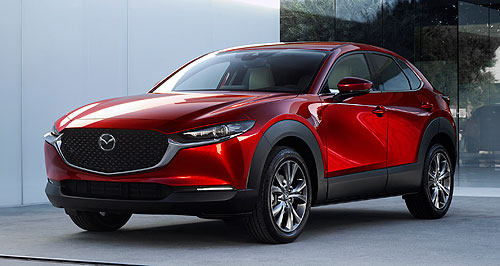Make / Model Search
Future models - Mazda - CX-30Geneva show: Mazda uncovers CX-30CX-30 joins Mazda Australia’s model line-up from 2020 as fifth SUV offering6 Mar 2019 By TUNG NGUYEN Mazda has used this year’s Geneva motor show to rip the covers off its box-fresh CX-30, a small-cum-mid-size SUV that will slot in between the CX-3 and CX-5 when it lands in Australian showrooms from next year.
Measuring 4395mm long, 1795mm wide, 1540mm tall and with a 2655mm wheelbase, the CX-30 will take on other larger small crossovers such as the Nissan Qashqai and Skoda Karoq, and raises Mazda Australia’s SUV stable to five models.
An evolution of the Japanese brand’s Kodo design language, the CX-30 is unmistakably Mazda thanks to smooth surfaces and subtle styling lines.
The front fascia is dominated by a large front grille and slender LED headlights, while prominent black-plastic underbody cladding gives away the CX-30’s small-cum-mid-size SUV body style.
The CX-30 also features a roof-mounted rear spoiler and slim tail-lights that flank a large 1020mm-wide rear opening, which also sports a low 731mm lip for easier loading of cargo.
Speaking of, European-spec versions boast a power-operated tailgate and 430 litres of boot capacity that sits right between the CX-3’s 264L and CX-5’s 442L.
Inside, the CX-30 mirrors the new-generation Mazda3 with soft-touch, upmarket surfaces and a large 8.8-inch central infotainment display.
While interior dimensions have yet to be revealed, Mazda says “there is plenty of legroom for rear-seat passengers and a low floor and high ceiling make the rear seats comfortable even for taller passengers”.
Nine exterior colours will be available on the CX-30, including Mazda’s signature Soul Red Crystal Metallic, Machine Grey Metallic and Polymetal Grey Metallic.
Underpinning the new CX-30 is Mazda’s latest batch of Skyactiv powertrains, including a 2.0-litre naturally aspirated petrol engine, 1.8-litre turbo-diesel unit and new sparkless-ignition Skyactiv-X mill.
Although details for the latter engine are yet to be revealed, the Skyactiv-G 2.0-litre engine under the bonnet of the new-gen Mazda3 develops 114kW/200Nm, while the Skyactiv-D 1.8-litre diesel produces 85kW/270Nm in the CX-3.
Drive is sent to all four-wheels via Mazda’s i-Activ all-wheel-drive system and either a six-speed manual or automatic transmission.
Built on Mazda’s new Skyactiv-Vehicle Architecture, the CX-30 also features the brand’s G-Vectoring Control Plus system as well as improvements to noise, vibration and harshness (NVH) levels when compared with older-generation vehicles.
Safety systems include a Driver Monitoring system that can detect fatigue and attention levels, front cross-traffic alert and an adaptive cruise control technology dubbed Cruising and Traffic Support.
Introducing the new CX-30 at the Geneva motor show, Mazda Motor Corporation president and CEO Akira Marumoto said: “We developed it (CX-30) for a wide range of customers, focusing especially on young people as they move through the different stages of life.
“It’s designed to become an essential partner in their daily lives,” he said.  Read more25th of February 2019  First drive: Mazda3 tuned on Aussie roadsMazda Australia had a strong stake in new-generation Mazda3 development22nd of February 2019  Mazda sticks by servicing programCapped-price servicing off the table for new-generation Mazda3 small car22nd of February 2019  New-gen Mazda3 priced from $24,990 BOCsMid-to-late April launch planned for Mazda’s top-selling Mazda3 small carAll future models Alfa Romeo Alfa Romeo Abarth Abarth Alpine Alpine Alpina Alpina Audi Audi Aston Martin Aston Martin BMW BMW Bentley Bentley Chery Chery Brabham Brabham Chrysler Chrysler Chevrolet Chevrolet Cupra Cupra Citroen Citroen DS DS Dodge Dodge Fiat Fiat Ferrari Ferrari Foton Foton Ford Ford Great Wall Great Wall FPV FPV Haval Haval GWM GWM Honda Honda Holden Holden Hummer Hummer HSV HSV Infiniti Infiniti Hyundai Hyundai Jaguar Jaguar Isuzu Isuzu Kia Kia Jeep Jeep Land Rover Land Rover Lamborghini Lamborghini Lexus Lexus LDV LDV Mahindra Mahindra Lotus Lotus Mazda Mazda Maserati Maserati Mercedes-AMG Mercedes-AMG McLaren McLaren MG MG Mercedes-Benz Mercedes-Benz Mitsubishi Mitsubishi Mini Mini Opel Opel Nissan Nissan Peugeot Peugeot Pagani Pagani Proton Proton Porsche Porsche Renault Renault Ram Ram Rover Rover Rolls-Royce Rolls-Royce Skoda Skoda Saab Saab SsangYong SsangYong Smart Smart Suzuki Suzuki Subaru Subaru Toyota Toyota Tesla Tesla Volvo VolvoMotor industry news |
Click to shareMazda modelsResearch Mazda All future models Alfa Romeo Alfa Romeo Abarth Abarth Alpine Alpine Alpina Alpina Audi Audi Aston Martin Aston Martin BMW BMW Bentley Bentley Chery Chery Brabham Brabham Chrysler Chrysler Chevrolet Chevrolet Cupra Cupra Citroen Citroen DS DS Dodge Dodge Fiat Fiat Ferrari Ferrari Foton Foton Ford Ford Great Wall Great Wall FPV FPV Haval Haval GWM GWM Honda Honda Holden Holden Hummer Hummer HSV HSV Infiniti Infiniti Hyundai Hyundai Jaguar Jaguar Isuzu Isuzu Kia Kia Jeep Jeep Land Rover Land Rover Lamborghini Lamborghini Lexus Lexus LDV LDV Mahindra Mahindra Lotus Lotus Mazda Mazda Maserati Maserati Mercedes-AMG Mercedes-AMG McLaren McLaren MG MG Mercedes-Benz Mercedes-Benz Mitsubishi Mitsubishi Mini Mini Opel Opel Nissan Nissan Peugeot Peugeot Pagani Pagani Proton Proton Porsche Porsche Renault Renault Ram Ram Rover Rover Rolls-Royce Rolls-Royce Skoda Skoda Saab Saab SsangYong SsangYong Smart Smart Suzuki Suzuki Subaru Subaru Toyota Toyota Tesla Tesla Volvo VolvoMotor industry news |











Facebook Twitter Instagram